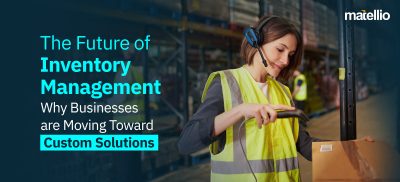
Software as a Service, or SaaS, is taking the business world by storm. SaaS solutions are preferred by most companies these days over traditional, license-based software tools.
According to a survey, 38% of companies are running completely on SaaS services, and 80% of businesses plan to make their systems SaaS by 2025.
The global demand for SaaS applications is steadily growing. And with the probability of 5G connectivity becoming a reality in the near future, SaaS applications are likely to become more popular. With that in mind, many businesses around the globe are working hard to either develop new SaaS applications or take their legacy, offline software and deliver them to their users in the SaaS model.
In today’s blog, we will learn all about SaaS and how you can develop a SaaS application for your business too.
What is SaaS? 
SaaS applications are subscription-based services delivered to the end-users using the cloud. These applications are web-based and have to be connected to the internet at all times.
SaaS can be considered a kind of delivery model for software in which no user is given a complete lifetime or yearly license to use a solution. Instead, they have to renew their subscriptions to use that solution continuously. This stands in stark contrast with the traditional license-based software delivery model in which users have to purchase expensive licenses if they want to use a software tool. Furthermore, they have to upgrade the software and maintain it constantly.
All of this adds a lot of load on the end-user side. Not many startups can afford to buy expensive licenses initially, and they don’t have the workforce to manage these elaborate software solutions.
SaaS solutions introduce a whole new level of ease to the enterprise IT landscape. Businesses no longer have to maintain clunky servers and buy licenses. They can get a subscription to one of the cloud services instead and be free of all the worries.
One thing about SaaS that really speaks to businesses is that the provider is responsible for everything. From updates and maintenance to data security, the service provider looks after everything. This makes the internal business process a lot more streamlined for companies.
Some of the top SaaS solutions on the market are Twilio, Atlassian, Microsoft Office 365, etc.
What are The Main Benefits of SaaS Services for The Providers?
While SaaS solutions offer plenty of benefits to end-users, service providers are drawn towards this delivery model for the following key benefits: 
Software Code Security
Companies are very protective of their solutions’ code base, as they should be. While there are plenty of measures businesses take to safeguard their traditional software code from being copied, tweaked, and reused by someone, it is still not enough, and code theft happens all the time.
But with SaaS, that is not possible because, technically, customers don’t own the software. These applications are still running on the service providers’ servers, and the users are simply getting access to those servers via their subscriptions. This eliminates any scope of code theft.
Scope to Innovate and Upgrade Quickly
With legacy software solutions, upgrades are a tricky thing. And what is even more tedious is the process of rolling changes out. Cloud servers can maintain app copies, which means while an application is being worked upon, it can still be available to the users. This eliminates the downtime factor from a software upgrade. Innovation on cloud is also relatively less tedious. Say a company wants to introduce a new feature to their app but isn’t sure how the users will respond to it. For SaaS, if the users are not happy, all the service provider has to do is revert the changes and make the previous version of the solution available. Whereas, for legacy software, things are not so simple.
Continuous Revenue
Buying licensed software is a one-time expense, whereas subscribing to cloud-based software is continuous. Thus with SaaS, companies have a steady stream of revenue. 
What are The Various Types of SaaS Applications?
There are two major types of SaaS solutions:
Traditional SaaS Solutions
Traditional SaaS solutions are those solutions in which the owner or the brand that owns that solution is visible to the users.
In most cases, these brands are the reason why people use those SaaS solutions.
For instance, Google Workspace, Slack, and even Adobe Creative Cloud are globally recognizable brands, and every user knows that they own the source code of the services they are using.
White-Label SaaS Solutions
While owned by their respective brands, these solutions allow users to customize and rebrand and resell these solutions as their own.
For instance, Wix, a popular cloud-based website builder, allows users to create their own websites, get their own domains and then sell that website to a third party, without ever disclosing to anybody that that site was built on Wix. Such solutions are called white-label SaaS.
Read More: How AaaS (Analytics as a Service) is revolutionizing data-driven decision making for modern businesses, explore our blog on Analytics as a Service
What is The Tech Stack Required to Build a SaaS Solution?
If you are looking to build your own SaaS solution, then you need a couple of tools to get started. While SaaS’s flexible model allows for any legacy software or idea to be implemented, it takes a lot of hard work and the right tools. Given below is the tech stack you will need to develop a SaaS solution for your business:
Multi-Tenant Architecture
For a SaaS to be truly scalable, it needs to work on a multi-tenant architecture. In simple terms, the multi-tenant architecture allows a server to run multiple applications simultaneously and allows multiple users to run an application. The lynchpin here is that the principle of exclusion is at work in this architecture. That is, even though multiple applications are sharing resources (computing, database, etc.) and multiple users are accessing the same application simultaneously, they all remain separate from one another. Thus every user feels like they have a dedicated instance of the application, and every application feels it has dedicated resources.
Content Delivery Network (CDN)
To deliver a software solution to different parts of the world, companies install a CDN. A CDN is a network of servers distributed across the globe that share load to provide better performance. Since these servers are available in all the locations where the service is available, it dramatically brings the response time down, thus enhancing the user experience.
APIs
APIs or application programming interfaces are used to add specific functionalities to an application without writing the code from scratch. These can be considered as add ons to cloud-based applications. There are APIs to implement a wide range of functionalities. For instance, when an eCommerce website asks you to make an electronic payment, they have used a payment API in their website that lets users communicate with their banks over the internet.
Load Balancers
Load balancers are a necessity for extremely popular services. They are responsible for distributing the incoming requests over the network in a fashion that every user gets the best possible experience.
Also Read – How To Build and Scale Your SaaS Billing Solution?
How to Develop a SaaS Solution for a Business?
Now that we have a reasonable understanding of SaaS solutions, let’s learn how to develop one for your business.
Software development is a tricky affair that requires a lot of commitment, workforce, time, and, most importantly, budget. Whether you are looking to migrate your legacy software to the cloud or create a new cloud-based solution, you will need an experienced SaaS application developer who knows that market inside out.
SaaS is an evolving sector. And with new technologies emerging every few months, service providers are trying their best to keep up with the demands of their customers. To excel in this landscape, you need to stay on top of market trends and be agile and quick. For all these reasons, a trusted software development partner with a stellar market reputation will not only help you launch your cloud-based solution but will also help you manage and update it.
While most big companies can afford to have big in-house development teams and cutting-edge infrastructure, not many startups have that kind of money initially. So for them, hiring full-time in-house developers is not the right move. Instead, they can hire a software developer to work on their solution for them. But if you don’t want to completely outsource your development, you can maintain a small in-house development team and augment it with IT staffing services. IT team augmentation providers rent you their talent at a fixed rate and for a fixed time period.
Research and Strategize
The first thing you need to do is figure out the hook of your SaaS solution. To stand out from a sea of SaaS solutions in the market, you need to clearly define your idea and determine what will pull people towards it. What is it that you provide that users can’t find anywhere else?
To polish your idea and define your app’s identity, you must learn about the market first.
Who are your competitors? What do the users want? What technologies are trending? And what are the shortcomings of your competitors?
Your goal is to make the weaknesses of your competitors your strength and figure out where the market is headed. If you jump on a trend when it is booming, by the time your product reaches maturity, the trend will already be over. No, you need to predict where the market is going and prepare for a future trend so that you can align yourself as the market leader when the trend arrives.
Market and competition analysis are crucial for your business plan. Once you know what your app is, you can start creating detailed plans. This phase is best done once you have hired a SaaS developer. The reason is, though your research was in-depth, there is no substitute for hands-on experience. Your SaaS solution developer will help you polish your business idea, guide you towards the proper technologies and help you make a sound business plan.
You will also need to finalize your budget and your business model. Once you have done your research and planning, it’s time to move on to the next stage.
Build and Release an MVP
An MVP or a minimum viable product is a lighter version of a full application. Given the unpredictable nature of the market and varying customer needs, there is no guarantee that a product will do well. So, most developers these days like to release a leaner version of their full-fledged apps in which they have implemented all the core features of the solution.
MVPs don’t compromise on quality. They have top-tier UI and UX design and the main idea of the solution, the heart of the application. They lack all the extra features that are nice to have but in no way prevent users from experiencing the main features in their absence.
There are many reasons why companies develop MVPs of their products these days. The biggest of them is that it’s the safest way of knowing whether their idea is good enough or not.
Developing a complete, feature-full software solution is a long and costly process. So if the solution bombs on release and is not received by the users well, that’s game over, and the companies suffer heavy losses. But instead, if they release an MVP that doesn’t take too long to build and is considerably cheaper, they can get the early reviews from the users.
Based on the criticism and feedback, they can then go back to the drawing board, fix things, and come back with a better version of the app. This way, the users get the solution they want, and the service provider doesn’t lose any money.
MVPs are also a great way to get more investors on board. An MVP that is being received well by the users will usually draw potential investors to you, thus giving you an opportunity to expand on your concept without worrying about the budget.
While an MVP is a lite version of a full solution, it must have:
Full Release and Marketing
Based on the feedback of your MVP, you will have to tweak your core features and then start working on the full version of your solution. A SaaS solution is feature-rich, so make sure you add as many useful features as possible without compromising on the performance. Once the development is done, test it thoroughly for bugs and finally release it.
Marketing your SaaS solution is of great importance. It doesn’t matter how great your solution is; if it has not been marketed properly, then people won’t know about it, and in the end, you will lose money.
Good software development goes hand in hand with good marketing planning.
Upgrade and Maintain
Once you have released your SaaS solution and people are using it, you need to start working on improving it. Based on the feedback, you need to provide technical support to the users and work on bug fixes. This will require you to release a couple of patches. Furthermore, you will have to keep releasing a steady stream of upgrades that your users will find useful.
The IT market moves too quickly these days; every year, some new technology surfaces, and users will forget about your solution if you don’t keep up.
Maintaining your servers, user guides, etc., is also a crucial part of the process. It will help if you make sure that your documents are up to date and your servers are in prime condition. 
Conclusion
SaaS solutions are quickly replacing legacy, license-based software. Most companies have already realized that instead of building their own infrastructure and purchasing expensive licenses, they can simply subscribe to powerful cloud-based services and receive way more benefits.
SaaS is the future of the enterprise IT sector. If you are looking to build a SaaS solution of your own or take your legacy software offering and bring it to the cloud, then Matellio is the right software development partner for you. With over a decade of experience, we understand the cloud better than most in the market. Matellio’s team of experts from a diverse range of niches allows us to meet every challenge head-on. With the help of our customer-centric development approach and the flawless implementation of the Agile development methodology, we deliver results that shatter customer expectations. If you are looking to hire a SaaS application developer, contact us today and book a free 30-minute consultation!








